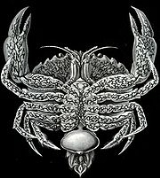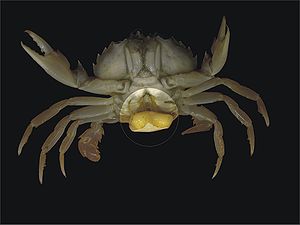
Sacculina
Encyclopedia
Sacculina is a genus
of barnacle
s that is a parasitic castrator of crab
s. The adults bear no resemblance to the barnacles that cover ships and piers; they are recognised as barnacles because their larval forms are like other members of the barnacle class
Cirripedia. Depending on the location, the prevalence of this unusual crustacean parasite in its crab host can be as high as 50%.
 The female Sacculina larva
The female Sacculina larva
finds a crab and walks on it until it finds a joint. It then molts, injecting its soft body into the crab while its shell
falls off. The Sacculina grows in the crab, emerging as a sac, known as an externa, on the underside of the crab's rear thorax
, where the crab's egg
s would be incubated.
When a female Sacculina is implanted in a male crab it will interfere with the crab's hormonal balance. This sterilizes it and changes the bodily layout of the crab to resemble that of a female crab by widening and flattening its abdomen, among other things. The female Sacculina has even been known to cause the male crabs to perform mating gestures typical of female crabs.
After this invasion of the Sacculina, the crab is now unable to perform the normal function of molting. This would result in a loss of nutrition of the Sacculina and impair its overall growth. The natural ability of regrowing a severed claw
that is commonly used for defense purposes is lost after the infestation of Sacculina. Although all energy otherwise expended on reproduction is directed to the Sacculina, the crab develops a nurturing behavior typical of a female crab. The natural hatching process of a crab consists of the female finding a high rock and grooming its brood pouch on its abdomen and releasing the fertilized eggs in the water through a bobbing motion. The female crab stirs the water with her claw to aid the flow of the water. When the hatching parasite eggs of the Sacculina are ready to emerge from the brood pouch of Sacculina, the crab performs a similar process. The crab shoots them out through pulses creating a large cloud of parasites. The crab then uses the familiar technique of stirring the water to aid in flow.
The male Sacculina looks for a female Sacculina adult on the underside of a crab. He then enters and fertilizes her eggs. The crab (male or female) then cares for the eggs as if they were its own, having been rendered infertile by the parasite.
Genus
In biology, a genus is a low-level taxonomic rank used in the biological classification of living and fossil organisms, which is an example of definition by genus and differentia...
of barnacle
Barnacle
A barnacle is a type of arthropod belonging to infraclass Cirripedia in the subphylum Crustacea, and is hence related to crabs and lobsters. Barnacles are exclusively marine, and tend to live in shallow and tidal waters, typically in erosive settings. They are sessile suspension feeders, and have...
s that is a parasitic castrator of crab
Crab
True crabs are decapod crustaceans of the infraorder Brachyura, which typically have a very short projecting "tail" , or where the reduced abdomen is entirely hidden under the thorax...
s. The adults bear no resemblance to the barnacles that cover ships and piers; they are recognised as barnacles because their larval forms are like other members of the barnacle class
Class (biology)
In biological classification, class is* a taxonomic rank. Other well-known ranks are life, domain, kingdom, phylum, order, family, genus, and species, with class fitting between phylum and order...
Cirripedia. Depending on the location, the prevalence of this unusual crustacean parasite in its crab host can be as high as 50%.

Larva
A larva is a distinct juvenile form many animals undergo before metamorphosis into adults. Animals with indirect development such as insects, amphibians, or cnidarians typically have a larval phase of their life cycle...
finds a crab and walks on it until it finds a joint. It then molts, injecting its soft body into the crab while its shell
Exoskeleton
An exoskeleton is the external skeleton that supports and protects an animal's body, in contrast to the internal skeleton of, for example, a human. In popular usage, some of the larger kinds of exoskeletons are known as "shells". Examples of exoskeleton animals include insects such as grasshoppers...
falls off. The Sacculina grows in the crab, emerging as a sac, known as an externa, on the underside of the crab's rear thorax
Thorax
The thorax is a division of an animal's body that lies between the head and the abdomen.-In tetrapods:...
, where the crab's egg
Egg (biology)
An egg is an organic vessel in which an embryo first begins to develop. In most birds, reptiles, insects, molluscs, fish, and monotremes, an egg is the zygote, resulting from fertilization of the ovum, which is expelled from the body and permitted to develop outside the body until the developing...
s would be incubated.
When a female Sacculina is implanted in a male crab it will interfere with the crab's hormonal balance. This sterilizes it and changes the bodily layout of the crab to resemble that of a female crab by widening and flattening its abdomen, among other things. The female Sacculina has even been known to cause the male crabs to perform mating gestures typical of female crabs.
After this invasion of the Sacculina, the crab is now unable to perform the normal function of molting. This would result in a loss of nutrition of the Sacculina and impair its overall growth. The natural ability of regrowing a severed claw
Claw
A claw is a curved, pointed appendage, found at the end of a toe or finger in most mammals, birds, and some reptiles. However, the word "claw" is also often used in reference to an invertebrate. Somewhat similar fine hooked structures are found in arthropods such as beetles and spiders, at the end...
that is commonly used for defense purposes is lost after the infestation of Sacculina. Although all energy otherwise expended on reproduction is directed to the Sacculina, the crab develops a nurturing behavior typical of a female crab. The natural hatching process of a crab consists of the female finding a high rock and grooming its brood pouch on its abdomen and releasing the fertilized eggs in the water through a bobbing motion. The female crab stirs the water with her claw to aid the flow of the water. When the hatching parasite eggs of the Sacculina are ready to emerge from the brood pouch of Sacculina, the crab performs a similar process. The crab shoots them out through pulses creating a large cloud of parasites. The crab then uses the familiar technique of stirring the water to aid in flow.
The male Sacculina looks for a female Sacculina adult on the underside of a crab. He then enters and fertilizes her eggs. The crab (male or female) then cares for the eggs as if they were its own, having been rendered infertile by the parasite.

